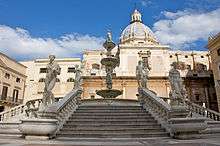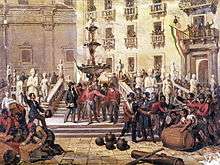Fontana Pretoria
The Praetorian Fountain (Italian: Fontana Pretoria) is a monumental fountain of Palermo. It is located in the heart of the historic centre and represents the most important landmark of Piazza Pretoria. The fountain was built by Francesco Camilliani in the city of Florence in 1554, but was transferred in Palermo in 1574.
| Praetorian Fountain | |
|---|---|
| Italian: Fontana Pretoria | |
 View of the fountain from Palazzo Pretorio | |
| Artist | Francesco Camilliani |
| Year | 1554 |
| Type | Public fountain |
| Medium | Marble |
| Location | Palermo, Italy |
| 38°06′55.75″N 13°21′43.5″E | |
History
.jpg)
Florentine origin
The fountain was created for the garden of don Luigi de Toledo in Florence.[1] Previously the land of the garden had belonged to the nuns of San Domenico al Maglio and was obtained, after a lot of pressure, in 1551. Subsequently, in 1584, the Palazzo di San Clemente was built on this site. The creation of this unusual garden (devoid of palaces) and of the fountain was commissioned to the Florentine sculptor Francesco Camilliani, student of Baccio Bandinelli.[1]
The work was started in 1554. The fountain included 48 statues and was surrounded by a long arbor formed by 90 columns of wood designed by Bartolomeo Ammannati. Giorgio Vasari called the fountain: «fonte stupendissima che non ha pari in Fiorenza nè forse in Italia» («wonderful-est fountain, that is unparalleled in Florence and maybe in all Italy»).[1]
Relocation to Palermo


In 1573 the indebted Luigi de Toledo (brother of the former Viceroy of Sicily García de Toledo), on the verge of moving to Naples, sold the fountain to the city of Palermo. In fact, the Senate of Palermo decided to buy the building e to place it in the square in front of the Palazzo Pretorio.
On 26 May 1574 the fountain arrived in Palermo. In order to transport it, the fountain was disassembled in 644 pieces. Then, in order to make room for the fountain, several buildings were demolished. However, the fountain arrived incompleted in Palermo. Some sculptures were damaged during the transport, others were maybe kept by Luigi de Toledo (probably the statues of two Divinities preserved in the Bargello Museum of Florence and other statues placed in Naples and then in the garden of Abadia, in the Spanish city of Cáceres).
Therefore, in Palermo some adjustment were necessary. The work of assembling was made by Camillo Camilliani, son of Francesco Camilliani. In 1581 he completed the work with the help of Michelangelo Naccherino.
Between 18th century and 19th century, the fountain was considered a sort of depiction of the corrupt municipality of Palermo. For this reason and because of the nudity of the statues, the square became known as "Piazza della Vergogna" (Square of Shame).
In 1998 the restoration of the fountain started. It was completed in 2003.[2]
Description
The fountain represents the Twelve Olympians, other mythological figures, animals and the rivers of Palermo.
Curiosity
In 1973, Italian National Postal Service dedicated a postage stamp to the Fontana Pretoria.
Gallery
See also
| Wikimedia Commons has media related to Fontana pretoria (Palermo). |
References
External links
- (in Italian) Image gallery
- (in Italian) Profile of the fountain - arte.it
- (in Italian) History of the fountain - Provincia Regionale di Palermo
.jpg)
_(6877773538).jpg)
.jpg)
.jpg)
.jpg)
.jpg)


